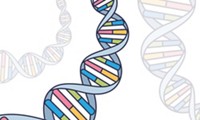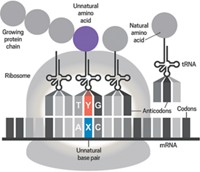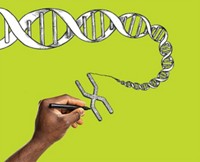Advertisement
Grab your lab coat. Let's get started
Welcome!
Welcome!
Create an account below to get 6 C&EN articles per month, receive newsletters and more - all free.
It seems this is your first time logging in online. Please enter the following information to continue.
As an ACS member you automatically get access to this site. All we need is few more details to create your reading experience.
Not you? Sign in with a different account.
Not you? Sign in with a different account.
ERROR 1
ERROR 1
ERROR 2
ERROR 2
ERROR 2
ERROR 2
ERROR 2
Password and Confirm password must match.
If you have an ACS member number, please enter it here so we can link this account to your membership. (optional)
ERROR 2
ACS values your privacy. By submitting your information, you are gaining access to C&EN and subscribing to our weekly newsletter. We use the information you provide to make your reading experience better, and we will never sell your data to third party members.
Biological Chemistry
Synthesizing Life
J. Craig Venter explores the meaning of life and the creation of synthetic organisms
by Laura Cassiday
January 27, 2014
| A version of this story appeared in
Volume 92, Issue 4

“What is life?” asked Austrian physicist and Nobel Laureate Erwin Schrödinger in a series of lectures at Trinity College Dublin, in 1943. Although countless others have asked the same question since the dawn of humanity, Schrödinger was one of the first to propose that the events within a living cell could be explained using physics and chemistry alone. He argued that even cellular activities as inexplicable, at the time, as heredity and creating order from chemical chaos must obey the laws of physics.

In the 70 years since Schrödinger’s groundbreaking lectures, the field of molecular biology has evolved at lightning speed. From James D. Watson and Francis H. C. Crick’s discovery of the chemical structure of DNA in 1953 to the sequencing of the human genome in 2000 and now to the “creation” of synthetic life in the laboratory, we are closer than ever before to understanding what it means to be alive. In his new book, “Life at the Speed of Light: From the Double Helix to the Dawn of Digital Life,” biochemist J. Craig Venter provides a compelling history of how scientists have learned to read and write the code of life, and he offers startling glimpses into the future of synthetic biology.
Venter, founder and chief executive officer of the J. Craig Venter Institute (JCVI) in Rockville, Md., and La Jolla, Calif., is best known as the maverick scientist who spearheaded a private effort to sequence the human genome ahead of the publicly funded Human Genome Project. In 1998, Venter founded Celera Genomics with the goal of sequencing the human genome in three years (compared with an estimated seven years remaining for the Human Genome Project). In contrast to the Human Genome Project’s more conservative approach, Celera scientists used a then-controversial method called whole-genome shotgun sequencing. Ultimately, the race to complete the human genome ended in a tie, with Celera and Human Genome Project scientists jointly announcing working drafts of the genome in June 2000.
In “Life at the Speed of Light,” Venter describes his effort to sequence the human genome as a fruitful diversion from his true passion: investigating the minimal genetic elements required for life and designing synthetic genomes. With these pursuits, he hoped to answer Schrödinger’s question.
For millennia, people believed that life was defined by a “vital spark” that infuses all organisms. This force distinguished living from nonliving materials and produced the organic compounds found in plants and animals. However, in 1828, German chemist Friedrich Wöhler astonished the scientific community by synthesizing urea, an organic compound previously obtainable only from animal sources. This discovery signaled the beginning of the end of the philosophy known as vitalism and laid the groundwork for Schrödinger’s hypothesis that life could be explained by the laws of physics and chemistry.
In the same year that Schrödinger delivered his lectures in Dublin, Oswald Avery discovered that DNA, not protein, is the genetic material. A decade later, in 1953, Watson and Crick solved the structure of the DNA double helix. The complementary nature of the nucleotides A, T, G, and C instantly revealed how DNA could replicate when cells divide.
The 1960s and ’70s brought new insights into how DNA replicates and gets transcribed into RNA and then translated into protein. The ability to splice DNA with restriction enzymes and to introduce DNA from one organism into another using recombinant DNA technology revolutionized molecular biology and gave scientists an unprecedented ability to manipulate the code of life.
In the mid-1970s, Frederick Sanger developed dideoxy DNA sequencing, which enabled his team at Cambridge to read the genome of the bacteriophage phi X 174. But it wasn’t until 1995 that sequencing technology evolved enough to allow researchers at Venter’s nonprofit research institute, the Institute of Genomic Research (now absorbed by JCVI), to sequence the much larger genome of a self-replicating organism, the bacterium Haemophilus influenzae. The genome sequences of several other bacterial species soon followed.
With bacterial genome sequences in hand, Venter hoped to identify a minimal set of genes required for survival. Using transposons, which are mobile genetic units, his team knocked out genes in one of the sequenced bacterial species, Mycoplasma genitalium, and observed whether the bacteria were able to survive. Venter’s team sequenced the DNA from survivors to identify which genes were disrupted by transposons. Because the bacteria could survive when these genes were disabled, the researchers scored the genes as nonessential for life.
But the team later realized that their scoring system was naive because some genes may be required for life only under certain environmental conditions. In addition, two genes may perform redundant functions, masking the effects of knocking out either one in isolation. Ultimately, Venter concluded that the only way to determine a minimal genome would be to synthesize an entire bacterial genome from scratch.
This task was easier said than done, however. In the late 1990s, automated DNA synthesis was fraught with errors. The longer the DNA sequence, the greater the potential for errors, making the process practical only for small DNA fragments. As a test project, Venter’s group decided to stitch together a tiny genome, that of bacteriophage phi X 174 (5,384 base pairs), from a series of overlapping 50-base-pair oligonucleotides. Although the researchers’ initial attempt to assemble viable viral DNA failed because of errors in DNA synthesis that produced truncated oligonucleotides, refinement of their methods eventually produced synthetic bacteriophage DNA that could infect bacterial cells.
Venter’s work immediately attracted the attention of U.S. government officials, religious leaders, and the public, who were concerned about potential misuse of the technology. For example, armed with a technique to produce synthetic viruses, bioterrorists might unleash deadly new epidemics. “At one extreme was the view that our work marked progress for humankind,” Venter writes. “At the other was the view that it was only the most recent example of scientific hubris, one that would inevitably lead to catastrophe.”
Yet Venter’s team charged on, setting their sights on a much larger synthetic genome, that of the bacterium M. genitalium (582,970 base pairs). By then, automated DNA synthesizers could reliably make 5,000–7,000-base-pair segments. The researchers developed a stepwise procedure to piece together 101 of these long segments into the full M. genitalium genome. At each stage of the assembly, the scientists cloned the growing fragments in Escherichia coli to produce enough DNA for the next stage. The ultimate step involved introducing four one-quarter-genome fragments into yeast. The yeast cells joined the four fragments together by homologous recombination, producing an intact M. genitalium genome. DNA sequencing confirmed that the genome was free from errors.
But Venter’s real tour de force was synthesizing the 1.1 million-base-pair M. mycoides genome and then transplanting the synthetic genome into another Mycoplasma species, M. capricolum. As the M. capricolum cells divided, some of them lost their original genome and “booted up” the M. mycoides genome. As a result, the bacteria changed from one species to another, replacing their own proteins with those encoded by the transplanted synthetic genome. “DNA was the software of life, and if we changed that software, we changed the species, and thus the hardware of the cell,” Venter writes.
Venter’s results, which were published online in Science on May 20, 2010, were heralded worldwide as a remarkable achievement. However, many questioned Venter’s claim to have “created synthetic life,” since the synthetic genome was essentially the natural genome sequence, and it was transplanted into a closely related species.
In “Life at the Speed of Light,” Venter takes issue with those who say he did not create life “from scratch.” He notes that the common definition of baking a cake from scratch involves combining the individual ingredients such as sugar, salt, and baking powder, but not synthesizing the ingredients themselves. By analogy, making a cell from scratch might involve using raw materials from an existing cell. Synthetic genomes could transform these raw ingredients into new life-forms not found in nature.
Venter is now working on a universal recipient cell that can transcribe and translate any transplanted DNA software. More ambitiously, his team is investigating whether they can create new cells without the need for preexisting cells by combining components such as enzymes, ribosomes, lipids, and synthetic genomes in vitro. Venter would not be Venter without making grandiose claims such as, “With synthesized DNA, it will eventually be possible to create all forms of life.” However, given the frenetic pace of molecular biology in the past 70 years, perhaps Venter’s statement is not as outlandish as it seems.
Although Venter does not ignore the ethical implications of his work, he largely dismisses the “well-worn criticisms about playing God.” He writes, “My greatest fear is not the abuse of technology but that we will not use it at all.” He sees many potential benefits of synthetic life-forms, from sustainable energy to drug and vaccine production.
The final two chapters of this book read somewhat like a science-fiction novel. Venter envisions being able to send a digitized version of DNA code in the form of electromagnetic waves to remote locations. A “digital-biological converter” at that location could then synthesize the DNA and use 3-D printing to create vaccines, antibiotics, or personalized drugs. Venter calls this process “biological teleportation” and notes that electromagnetic sequence information could be sent to Mars in as little as 4.3 minutes, providing future colonists with therapeutics and other supplies. JCVI has developed a prototype digital-biological converter that can synthesize DNA but not yet proteins or cells.
What is life? Venter thinks he has the answer: Life consists of DNA-driven biological machines. Synthetic biology seeks to free life from the shackles of evolution, creating new organisms with designer genomes. Whether the technology results in the benefits to humanity envisioned by Venter, or the horrors predicted by cautionary tales such as “Frankenstein” and “Jurassic Park,” remains to be seen.
Laura Cassiday is a freelance science writer and editor. She is based in Denver.





Join the conversation
Contact the reporter
Submit a Letter to the Editor for publication
Engage with us on Twitter